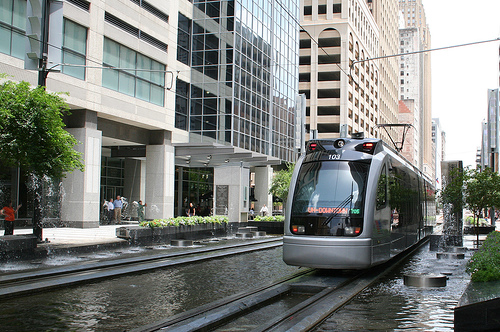Is Houston the next great sustainability hub?
Houston, Texas, the country’s fourth largest city, an oil-powered metropolis known for its seemingly unstoppable urban sprawl and car-centric culture, is undergoing a promising evolution in environmental and planning policies.
For one, Mayor Annise Parker was appointed to the president’s national Task Force on Climate Change. Additionally, Houston was named as a Climate Change Preparedness Pilot, and is now one of two American cities on the C40 Cities Climate Leadership Group’s Steering Committee, reports Houston Tomorrow. (That Committee, incidentally, only has 12 world cities total.)

The addition of light rail and BRT, plus other public transit and climate change initiatives, have transformed Houston into a more sustainable city in recent years. From eschipul.
So against all odds, Houston has transformed itself into a sustainability hub in recent years. As On Earth Magazine rapid bus transit extension aimed at the city’s commuters will begin early next year, the Houston Chronicle reported in August, with buses to begin service in 2017.
The city is also in the process of constructing light-rail lines traveling downtown, in part to afford tourists and residents access to local attractions.
Still, there remain some concerns. Biking — an indicator of sustainability — has been experiencing a boost in popularity; Houston B-Cycle, the city’s bike-sharing program, was launched in 2012. Yet some advocates are concerned for the future of biking in the city: As Robin Stallings, executive director of BikeTexas, recently editorialized, the state’s transportation department recently displaced $29 million of a total $35 million in funds that were intended for sidewalk, hike, and bike trail construction. (The state contends the funds will still benefit the same projects.)
Houston’s parking minimums — a handy indicator of just how auto-centric a city is — have also been raising concern. In the last two years, the city has considered special guidelines for permit-only, resident parking, as well as guidelines that would require most restaurants to two additional parking spaces per 1,000 square feet of floor area (from 8 spaces to 10 for most restaurants; and from 10 to 14 spaces for bars).
“Houston is sincere about trying to remake its inefficient, 20th-century sprawl into a 21st-century vertical metropolis—a place that transcends its deep historical roots in fossil fuels by acknowledging their instrumental role in a changing climate and by reducing its consumption of them accordingly,” summarizes On Earth Magazine.
Commitment to building a cyclist- and pedestrian-friendly community with a reconsidered focus on drivers’ needs will reveal just how sincere the city is about its transformation.
Related Posts
Category: Infrastructure, Transportation

















